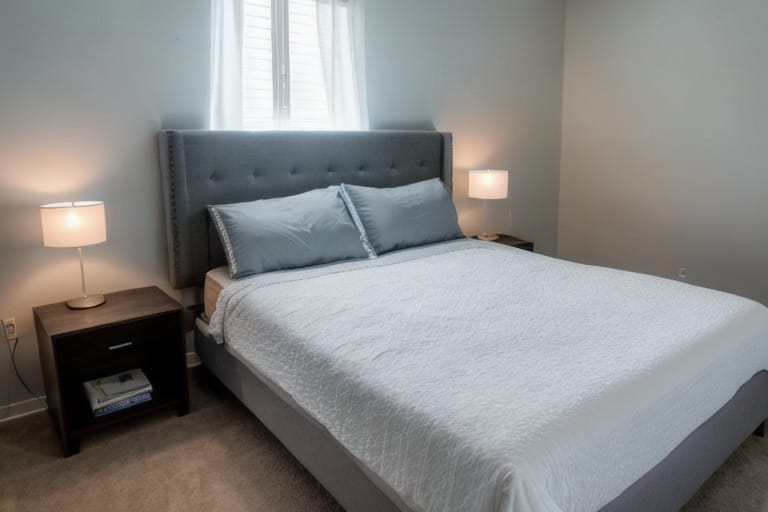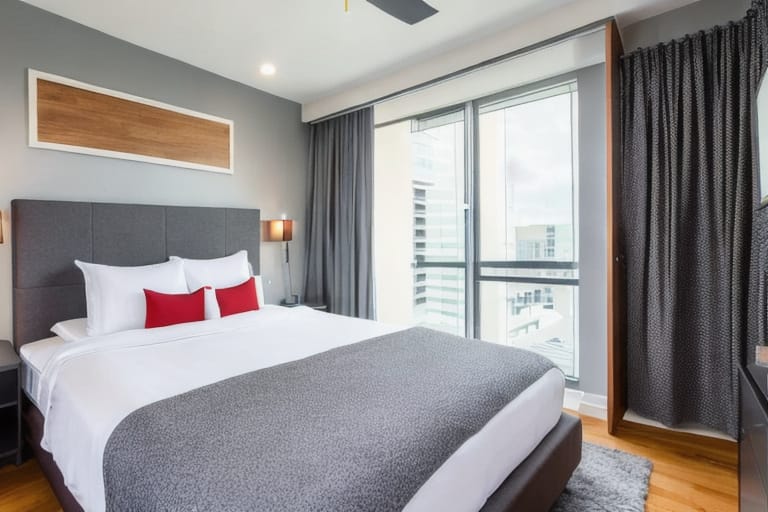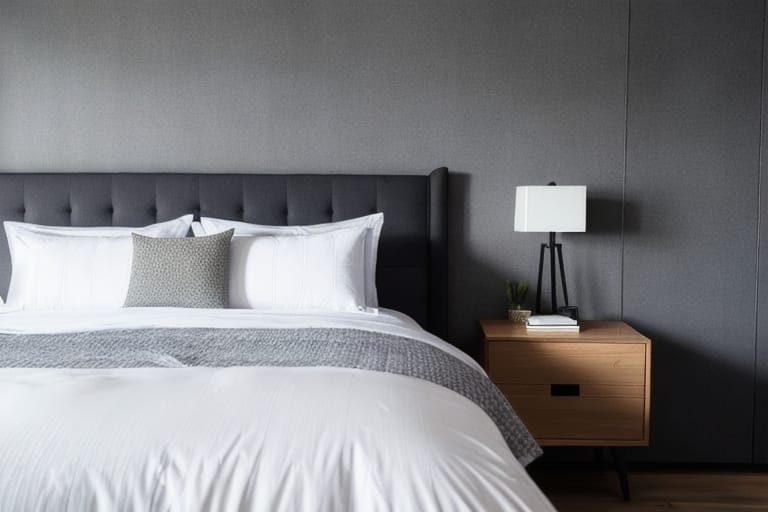When it comes to selecting the perfect bedding to keep you warm and comfortable all night long, one of the biggest dilemmas is deciding between a down comforter or a down alternative comforter. Both have their advantages and disadvantages regarding factors like warmth, cost, environmental impact, and care. This beginner’s guide will compare these two popular comforter types so you can determine which is better suited for your needs and preferences.
What is a Down Comforter?
A down comforter is filled with the fluffy underside feathers from ducks or geese called down. This natural fill material creates a puffy, billowy comforter that is highly praised for providing superior warmth and comfort.
The down cluster’s 3D structure is perfect for trapping body heat. As you sleep underneath a down comforter, the feathers expand to fill the available space and insulate your body. This creates a protective layer that retains warmth and keeps cold air out.
Down comforters come in different fill powers, typically between 400 to 900. The fill power indicates the fluffiness and insulation ability of the downfall. Higher fill powers (600 to 900) have more loft and air pockets to better retain warmth. This makes them ideal for cold climates, while lower fill powers around 400 may suit warmer areas.
The outer shell of a down comforter is usually made from lightweight, breathable fabrics like cotton, cotton sateen, or cambric cotton. Along with the fill power, this impacts the overall warmth level. The shell prevents feathers from poking through while allowing airflow.
Down comforters can last over a decade with proper care. The biggest downside is the high price tag, typically $200 to $500 depending on the fill power and materials.
Types of Down
You may see references to goose down, duck down, or swan down when comforter shopping. Here’s how they compare regarding softness, warmth, and durability:
- Goose Down is top-tier with the largest clusters that trap more heat. It has unrivaled fluffiness and longevity.
- Duck Down also provides great insulation at a slightly lower cost. The clusters are smaller than goose down.
- Swan down is extremely rare, light, and fine. It is the warmest and most expensive down you can buy.
Exploring Down Alternative Comforters
For those with allergies or seeking a vegan option, down alternative comforters are filled with animal-free synthetic materials to mimic the qualities of down. Common materials include:
- Polyester – Most widely used down alternative with hypoallergenic properties. Affordable and durable.
- Microfiber – Extremely soft synthetic with moisture-wicking abilities. Higher price point than polyester.
- Cotton – Natural plant-based fill though less warm than other synthetics. Environmentally friendly.
- Rayon – Made from bamboo or other sources. More breathable than other synthetics.
The synthetic fills used in down alternative comforters are inherently hypoallergenic. This makes them ideal for those with allergies or sensitivities. They are also vegan-friendly since no animals are used in manufacturing.
Most down alternative comforters have a cotton or cotton-blend shell. Unlike down, the fill lacks the structure to fully expand and fill space. So alternative comforters rely more on the shell to prevent heat loss.
Affordability is the main advantage over down comforters – prices typically range from $50 to $150. The fill materials also make down alternatives fairly easy to clean and care for long-term.
Downsides include less durability than down comforters, with the fill becoming less lofty over a few years. They may also sleep hotter due to slightly less airflow from the denser synthetic fills.
Comparing Warmth and Temperature Regulation
When it comes to keeping you cozy and comfortable all night, warmth is a top priority. Here is how down-and-down alternatives compare regarding heat retention and adapting to your body temperature:
Down Comforters Regulate Temperature Through Fill Power
The clustered structure and high fill power of down creates featherlight layers of insulation. As you sleep, the down expands and compresses to retain warmth while releasing excess heat.
This gives the comforter excellent breathability to prevent overheating. The more baffle boxes (inner compartments) in the comforter, the better the down fill can expand and respond to your body’s temperature changes.
The fill power also determines the seasons a down comforter can be used:
| Fill Power | Suitable Temperatures |
|---|---|
| 400 to 500 | Spring/Fall or mild winters |
| 600 to 700 | Year-round for most climates |
| 800 + | Excellent for cold winters |
So you can choose an appropriate fill power based on your climate and whether you tend to sleep hot or cold. Those who run hot may want a lower fill, while cold sleepers need higher fill power down.
Down Alternatives Rely On Shell Fabrics For Breathability
In down alternatives, the synthetic microfibers lack the delicate structure to adjust to your body heat like down. So the comforter relies more on the exterior shell to allow airflow and release warmth.
Materials like cotton and cotton blends have tiny pores in the fabric weave to circulate air. This prevents moisture buildup from sweat and allows adequate airflow for most sleepers.
The denser fills also take longer to compress or expand in reaction to temperature changes. So down alternatives may sleep slightly warmer, though likely not enough to cause discomfort or night sweats.
Those worried about heat retention can choose lighter weight down alternatives with less fill. But the overall warmth levels typically can’t match the customized climate control of high fill power down comforters.

Comparing Allergen Considerations
Allergies are one of the top reasons for choosing a down alternative comforter. Here’s how the two options compare when it comes to allergen sensitivities:
Ethical Down Sources Reduce Allergen Concerns
Goose and duck down itself should not trigger any allergic reaction – it’s the dust, pollen, mold, and other contaminants that cause issues. Many comforters now use Responsible Down Standard (RDS) certified down that is cleaner with fewer allergens:
The RDS process ensures down is ethically sourced from ducks and geese with cleaning methods that greatly reduce allergens. It also requires third-party auditing for responsible animal welfare practices.
With proper cleaning and storage, a high-quality down comforter from ethical sources will have minimal concerns regarding allergen triggers or odors over time.
Synthetic Fills Eliminate Allergy Worries
One definite advantage of down alternative comforters is the hypoallergenic properties of the synthetic polyester fiber fills. The manmade materials leave zero risk of allergens from animal products.
And because the fills are less breathable than down, that also means less airflow bringing in dust mites or other triggers. So those with more severe allergies and asthma may find down alternatives more suitable.
The tradeoff is these materials lack the delicacy, cloud-like softness, and warmth insulation of premium down. But for allergy prevention, synthetics like polyester or microfiber excel.
Comparing Fill Power and Construction
A comforter’s ability to trap heat depends largely on the fill material and construction method. Here is how down and down alternatives differ:
Baffle Boxes Optimize Down Distribution
In a baffle box construction, fabrics form inner compartments evenly spaced throughout the comforter. These baffles section off the fill to prevent shifting and ensure even distribution:
Combined with a breathable shell, this allows the ultra-fine down clusters to fully expand and conform to your body shape as you sleep.
More baffles provide better insulation through preventing gaps in warmth. Down comforters usually have at least 15 baffle boxes though high-end options may have 50+.
Quilting Creates Structure In Synthetic Fills
Because alternative fills lack the airy structure of down, they require quilted patterns in place of baffles to maintain even distribution:
The stitching creates chambers that mimic baffle boxes so the fill stays evenly distributed. This helps the comforter retain shape and warmth over the years.
While not as breathable as down clusters, the quilt compartments allow some heat transfer and airflow. Personal preferences in weight and warmth level can help choose an appropriate fill for your sleep needs.
Factoring In Durability and Longevity
Investing in a quality comforter means considering how well it will withstand regular use and cleaning over time. Let’s compare durability:
Premium Down Offers Multi-Year Durability
The delicate structure of high fill power down makes it unrivaled in airiness, loft, and cloud-like billowy comfort. With its natural resilience, down can spring back to full fluffiness repeatedly.
Over decades of use, even the highest quality down will compress down slightly. But with adequate care, a 600 to 800 fill power-down comforter can retain excellence for 15 years or longer. This makes the initial investment worthwhile long-term.
To extend lifespan, use a large-capacity commercial washer on delicate settings. Tumble dry low and fluff the down after air drying each year. With proper care down only gets softer and cozier over time!
Budget-Friendly Down Alternatives Are Less Hardy
The synthetic fills used in alternative comforters tend to be less durable and resistant to repeated washing. The fibers lose structure and “clump” more easily than featherlight down clusters after a few years.
Most manufacturers rate alternative comforters at retaining optimal warmth and softness for 2-8 years with regular use before needing replacement. Proper cleaning and storage help prolong lifespan nearer to the high end of that range.
The affordability of these comforters makes replacing them more reasonable once the fill’s loft and softness deteriorate. Just expect to invest in a new down alternative comforter twice as often as you would with premium down.
Comparing Environmental Factors
For eco-conscious consumers, understanding the environmental impacts behind a comforter’s production is key. Here’s how down and synthetic options compare:
Sourcing Standards Minimize Down’s Footprint
In the past, down comforters raised concerns regarding animal cruelty and unsafe sourcing methods. Now however most major manufacturers use RDS-certified down for ethical standards.
The Responsible Down Standard audits supply chains ensuring humane treatment and non-live plucking harvesting methods. This alleviates worries over animal welfare and related environmental considerations.
Once in use, a down comforter is also a sustainable product providing over a decade of cozy sleep. And the materials biodegrade naturally, avoiding landfill contributions. This checks the boxes for an environmentally responsible investment.
Down Alternatives Use Recycled Materials
For vegans and animal lovers, down alternatives offer cruelty-free nighttime comfort. Most fills now incorporate recycled plastics stemming from post-consumer waste streams:
By transforming trash into cozy bedding, manufacturers reduce impacts linked to virgin plastic production. This innovation makes down alternatives compete with down’s sustainability.
Just beware that not all down alternatives use recycled materials so check company commitments if ethical sourcing is important to you. With mindful production, synthetic fills make greener alternatives to down.
Cost and Affordability Comparison
One of the biggest factors in choosing bedding is cost and overall value for money. Down comforters have higher upfront prices while down alternatives offer budget savings:
Splurge-Worthy Down for Premium Quality
The highest quality materials and expert craftsmanship carry premium price tags – expect to invest $350 to $500 for ultra-soft high fill power down encased in Egyptian cotton or silk shells:
But rest assured that investment will reward you with heavenly comfort night after night for over a decade or more. So determine your budget and choose the best down comforter you can afford. Even mid-range options around $200 still provide exceptional coziness far surpassing any synthetic.
Budget Savings from Value-Packed Down Alternatives
The synthetic fills used in down alternative comforters cost a fraction to produce compared to premium goose down. This means very comfortable options available from just $50 to $130.
While not matching the opulent feel and longevity of high-fill power down, these comforters make cozy bedding accessible for tighter budgets. Plus they avoid any ethical concerns over animal products.
With innovative microfibers and recycled materials, down alternatives keep improving warmth and softness. Easy care makes replacement more practical after 5-8 years once compression sets in. Overall outstanding value balancing quality and price.

Finding Your Perfect Fit
With so many factors beyond cost determining suitability, take your individual needs and priorities into account when choosing between down and down alternatives.
Points for Down Comforter Buyers:
- Choose an appropriate fill power based on your climate and temperature preferences
- Check for ethical sourcing standards like RDS certification to alleviate allergen concerns
- Select a lightweight, breathable shell fabric complementing the fill power
- Expect unmatched longevity from quality construction and materials
- Budget for dry cleaning every 2-3 years for optimal care
Considerations for Down Alternative Shoppers:
- Pick a fill weight suiting your warmth needs without overheating
- Verify hypoallergenic properties if allergies are a concern
- Prioritize affordability as durability lags behind down
- Choose ethical and environmentally friendly materials if important
- Enjoy easy machine washing and drying at home
And don’t hesitate to check reviews or ask bedding experts if uncertain whether a down or down alternative comforter better matches your priority features. The key is determining attributes that align with your sleep habits, climate, budget, and values for long-lasting satisfaction.
Frequently Asked Questions
Is a down comforter or down alternative better for hot sleepers?
Down comforters provide superior breathability and temperature regulation. The fill power and baffle box design allow more airflow to release excess heat. So hot sleepers often prefer down comforters with lower fill power around 400-500.
What is more important when comparing comfort: fill power or fill weight?
For down comforters, the fill power indicating loft and insulation ability is most vital. Higher fill powers trap more air and retain more warmth. For down alternative synthetic fills, fill weight matters most since the materials lack the delicate clustered structure of down.
How do I make a down comforter last longer?
Protect your investment in a quality down comforter by following proper care guidelines. Use a large capacity washer on a delicate cycle with mild detergent, then tumble dry low and fluff back to full loft. Store the comforter loosely in a breathable cotton case. And consider professional dry cleaning every 2-3 years.
Should I pay more for goose down or opt for cheaper duck down?
Goosedown offers superior insulation, longevity, and cloud-like softness. But duck down also provides excellent warmth at a more affordable price point. Evaluate your budget and desired balance of quality vs. cost. For frugal buyers or less extreme climates, duck down likely suffices.
How often should I replace a down alternative comforter?
Most down alternative comforters maintain optimal cozy warmth for 5-8 years with proper care. The synthetic fills tend to break down and get lumpy compared to resilient down clusters. Budget for replacement about twice as often as you would for a premium down comforter.
What’s the benefit of ethically sourced down?
Opting for down comforters with fill certified by the Responsible Down Standard (RDS) ensures humane treatment of geese and ducks. The third-party audited standard prohibits live-plucking and ensures traceability. And the methods used result in down with less odor or allergen issues.
Which is better for allergy sufferers: down alternative or hypoallergenic down?
Those with more severe allergies may wish to avoid animal products altogether with a synthetic down alternative fill. But for mild symptoms, down certified to the Responsible Down Standard (RDS) undergoes stringent cleaning methods to reduce allergens. Discuss options with your doctor if uncertain.








